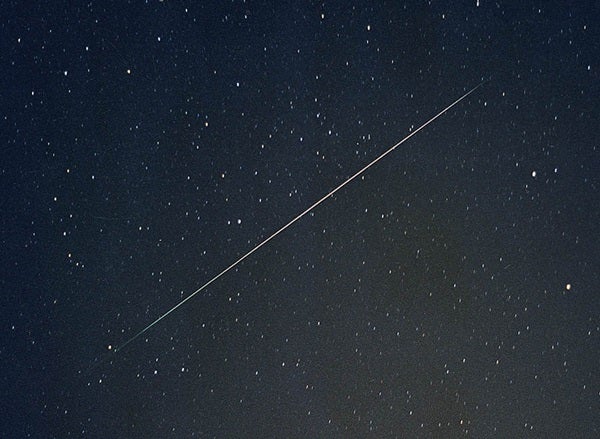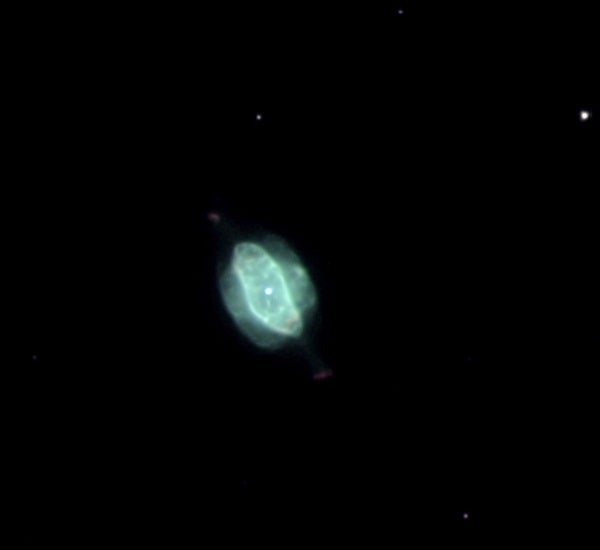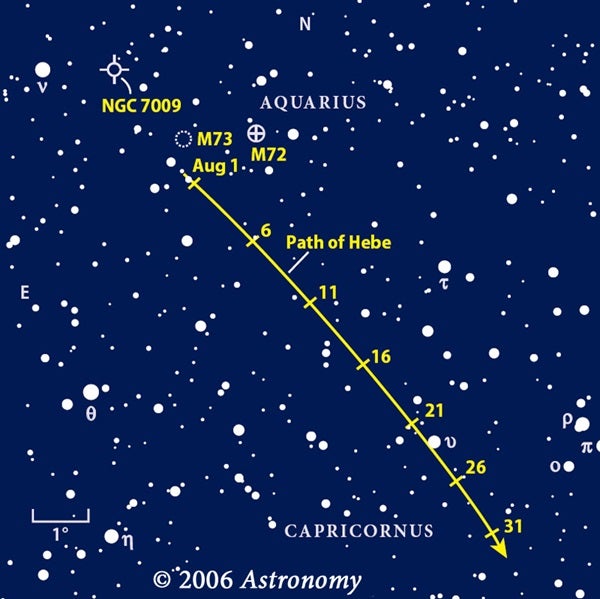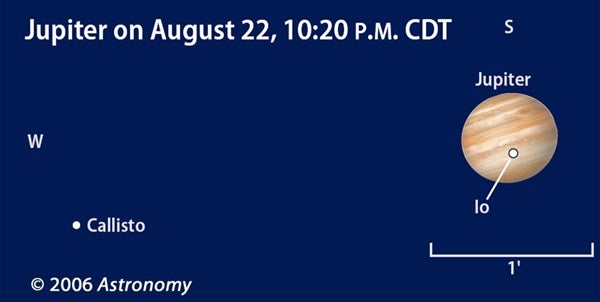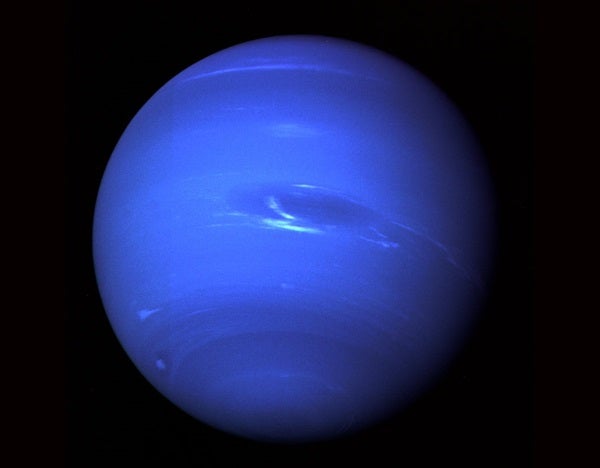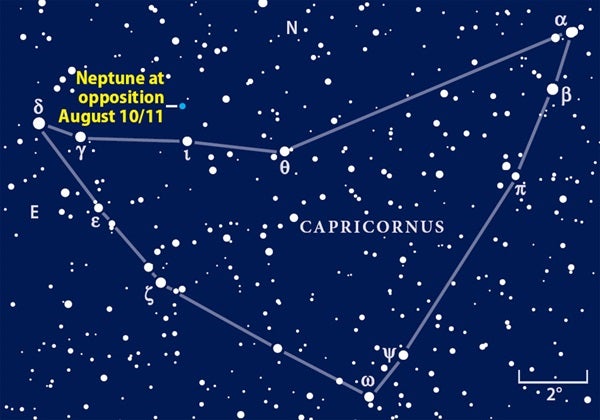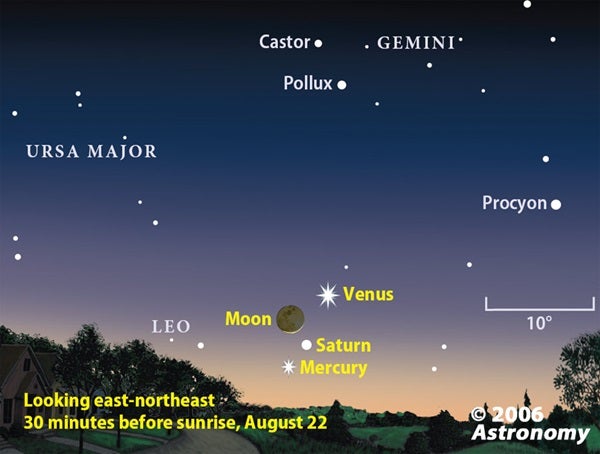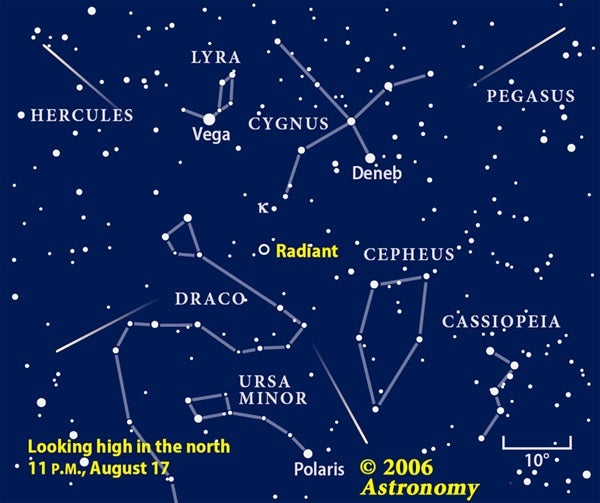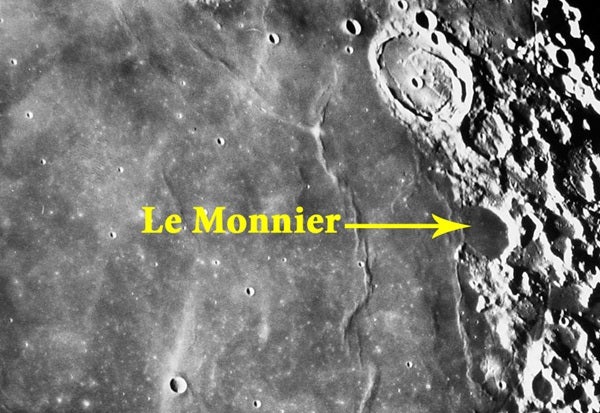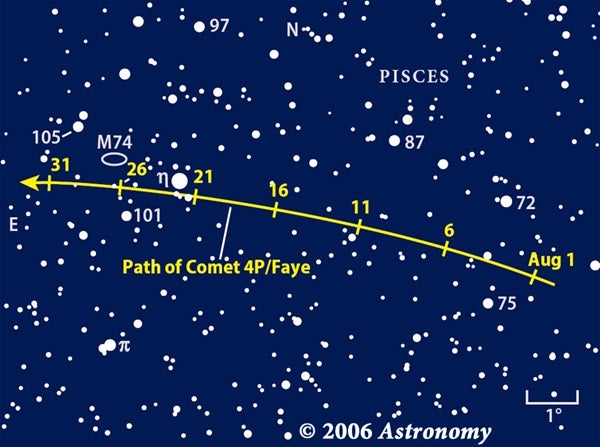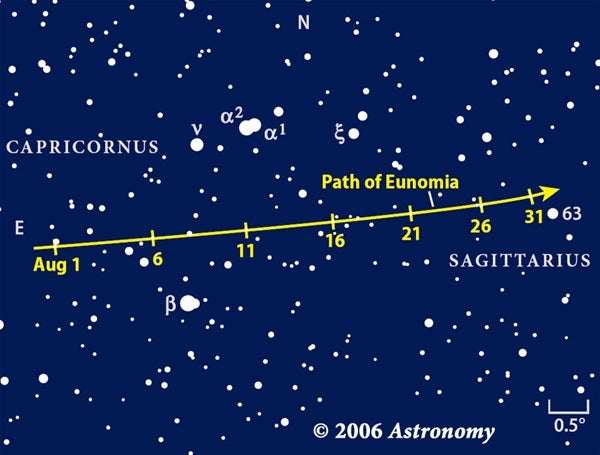Through the ages, Comet 109P/Swift-Tuttle has spread motes of dust along its orbit as it passed through the inner solar system. When Earth sweeps through this band every year in mid-August, the dust burns up from friction with the upper atmosphere. The entry speed clocks in at a blistering 37 miles per second, giving rise to the Perseids’ bright flashes.
Meteor rates should be lower than usual this year because bright moonlight will hide the fainter streaks. The Perseids run around half-strength a night on either side of maximum, so watch then if the weather looks bad for the peak.
Meteor watching is a great family or group activity because you don’t need any optical equipment. And it’s easy to stay enthusiastic during a dry spell when someone else sights a shooting star and lets out an audible “ooh.” Bring along blankets, sleeping bags, and hot chocolate because August nights can seem cool after a hot day. See “Party with the Perseids!” on page 76 for more meteor-observing details.
In the deepening twilight this month, a bright beacon shines fairly low in the southwest. This is the king of planets, giant Jupiter. Despite lying some 500 million miles from Earth, its huge girth reflects a lot of sunlight toward us, enough to outshine the brightest stars in the sky.
Less than 4 years from now, we’ll reach the 400th anniversary of Galileo’s discovery of Jupiter’s four biggest moons. The smallest telescope will reveal these tiny dots next to Jupiter’s bright disk, and even steadily held binoculars makes this feat possible.
What’s a star party? It’s when dozens or hundreds of amateur astronomers get together far from city lights to appreciate the wonders of our universe. If you’ve been trying to figure out which telescope to buy, this is a great spot to see many in action and talk to owners about the equipment’s pros and cons. Just ask before you touch. Check out “Coming events” on page 94 to find the nearest star party, or ask at your local planetarium or science center.
Out in the country darkness, you’ll notice a wide band of light crossing the sky. Called the Milky Way because of its appearance, this soft-white glow gave its name to our galaxy, home to hundreds of billions of suns. The glow comes from the combined light of these stars inhabiting the galaxy’s spiral arms nearest to Earth. Toward the southern part of the sky, the glow gets brighter and broader — this is our galaxy’s hub.
After midnight, once Earth has turned the sky westward, the constellation Aquarius stands where Jupiter was at dusk. A different gas-giant planet, Uranus, now lies here. Its smaller size and greater distance leave it glowing much fainter than Jupiter. At magnitude 5.7, Uranus is just bright enough to see without optical aid from a dark site. From a suburban backyard, you can track it easily with binoculars. While you’re at it, take the opportunity to track a couple of nearby asteroids.
The monthly cycle of our Moon brings it below Jupiter August 1 and again on the 29th.
Notice how the Moon’s phase has thinned, indirect evidence for Earth’s movement around the Sun. If you’re an early riser, or on summer holiday, make an effort to look east an hour before sunrise. The Last Quarter Moon approaches the beautiful Pleiades star cluster (M45) August 16. Meanwhile, close to the horizon, brilliant Venus guides the way to Mercury. Late in the month, Venus skims just north of ringed Saturn.
It’s amazing how the spiral pattern of a distant galaxy can resemble an earthly hurricane, despite the huge difference in scale. In another cosmic coincidence, a large gas cloud more than a light-year across looks like a ghostly version of the beautiful planet Saturn when its rings appear close to edge-on.
Located in southwestern Aquarius roughly 3,000 light-years away, the Saturn Nebula (NGC 7009) glows with the light of an 8th-magnitude star. Through a 4-inch telescope at low power, the nebula looks like a slightly out-of-focus star, a little softer than its neighboring pinpoints. Bump up the power to 150x to see the fairly well-defined disk. With an 8-inch, you should notice some blue-green color when you look straight at it. In low-light conditions, a sideways glance (averted vision) is black and white. Only central vision detects color.
Just visible in a 12-inch, and spectacular in a big “star party” scope, are the two straight extensions that inspired Lord Rosse to name it the Saturn Nebula in the mid-1800s. Because of this planetary nebula’s high surface brightness, it can withstand a lot of power and begins to look like a Hubble image without the color. If a big-scope owner is willing to show it off, you will even see the bumps on each extension, which are called “ansae.”
A pair of Messiers
“Quaint” pretty much sums up the mismatched pair of deep-sky objects cataloged as M72 and M73. M72 is a distant globular cluster, while M73 is classified as an asterism — it’s nothing more than a group of four modest stars.
Perched in the halo of our galaxy some 55,000 light-years away is M72. Its 200,000 stars put out enough combined light to show up in a small telescope. The great distance reduces it to a fuzzy cotton ball glowing at magnitude 9.2. A 6-inch scope at high power under a dark sky will pick up a few of the cluster’s red giant stars, giving the object an overall granulated appearance.
A rock at max
It’s not often we find a bright asteroid in the vicinity of a Messier object, so we’ll let 6 Hebe point the way to this month’s deep-sky objects. At magnitude 7.9, Hebe will be easy to locate less than 1° south of M73 August 1. It then heads south into Capricornus. From under dark skies, Hebe is within reach of binoculars, but a small scope from a suburban backyard can pick it up. Can you see which “star” moves from one night to the next?
Jupiter currently lies among the faint background stars of Libra the Scales. Watch the planet draw closer to 3rd-magnitude Zubenelgenubi (Alpha [α] Librae) throughout the month. The gap shrinks from 5° to 2° thanks to Jupiter’s orbital motion tempered slightly by Earth’s own movement around the Sun.
Jupiter’s visible “surface” — actually the upper deck of its cloud belts — changes hourly.
It makes a fine target for telescopes both big and small. The planet’s disk spans 37″ August 1 and shrinks slightly during the month as Jupiter’s distance from Earth increases. Observers can get up to 2 hours of observing time each night before Jupiter sinks too low. It sets around midnight August 1, and 2 hours earlier by month’s end.
Jupiter’s four major moons — Io, Europa, Ganymede, and Callisto — continue their perennial waltz back and forth, in front and behind, the planet. The positions change from night to night and, in the case of the two inner moons, the motion can be seen hourly.
You’ll have little trouble seeing Jupiter’s shadow eclipse the moons this month because the planet lies 90° east of the Sun (a point called quadrature). This places Jupiter’s shadow as far from the planet’s disk as it can get from our earthly perspective, so the gleaming planet doesn’t interfere much.
Ganymede provides the best views because it enters Jupiter’s shadow well east of the planet’s disk. Io and Europa lie too close to Jupiter for us to observe an eclipse’s beginning. (These moons enter the planet’s shadow while still hidden behind the disk.) And Callisto orbits far enough from Jupiter it completely misses the shadow.
Occasionally, three jovian moons simultaneously undergo either an eclipse or transit in front of Jupiter, leaving only one moon visible. Three such times occur this month, one visible from Europe and two from North America. For the European event, watch between 1:17 A.M. and 2:06 A.M. British Summer Time August 16. Europa and Ganymede will then be in eclipse, while Io is in transit. This leaves only Callisto visible. North Americans can witness two events just a week apart. Only Callisto will be on view from 11:14 P.M. to 12:23 A.M. EDT the night of August 22/23, and again between
12:11 A.M. and 12:31 A.M. EDT August 30.
Pluto stands 0.5° southwest of the 3.5-magnitude star Xi (ξ) Serpentis August 1. This distance increases to 0.8° by month’s end. This proximity greatly eases the task of finding Pluto’s field. Still, seeing the 14th-magnitude planet is a supreme challenge for visual observers with an 8-inch scope. The challenge becomes more manageable with a larger light-collecting area. And the task becomes easier still with a good digital or CCD camera. Pluto lies 2.8 billion miles from Earth.
Neptune’s cousin, Uranus, is a month away from opposition and so lies farther east, within the borders of the constellation Aquarius. A dark-sky location offers observers the chance to spot Uranus, which glows at magnitude 5.7, without any optical aid. To attempt this feat, observe when Uranus lies near its highest point in the south (a little past local midnight) on a night with excellent atmospheric transparency, such as you’ll find after a summer storm blows through.
During August’s first week, Uranus lies close to a slightly fainter star, 81 Aquarii (magnitude 6.2). The seventh planet passes less than 0.1° south of the star August 6. On the 10/11th, the planet lies less than 1° north of the waning gibbous Moon. Uranus continues to move westward all month, ending August 1.3° due east of Lambda (λ) Aquarii.
Take a peek at Uranus through a telescope to see its 3.7″-diameter disk. Color perception is subjective, depending on each person’s retinas, but most observers detect a blue-green hue. Compare its color with Neptune’s duller hue.
A trio of planetary conjunctions or near conjunctions occurs in August’s morning sky, along with one of the best morning views of Mercury in 2006. Venus has spectacular meetings with both Mercury and Saturn; Mercury and Saturn also undergo a conjunction.
Three days later, Venus and Mercury come within 2° of each other, as they together traverse the constellation Cancer the Crab. On August 16, Mercury passes 1° south of
the Beehive star cluster (M44), followed by Venus August 19. Twilight will hinder your view of the Beehive.
As these planets move east relative to the stars, Saturn rises to meet them. Although Saturn lies behind the Sun from our perspective August 7, it reappears in the morning sky by August’s third week. On the 21st, less than 1° separates Mercury and Saturn. By then, Mercury has brightened to magnitude –1.5, while Saturn appears 6 times fainter, at magnitude 0.4.
The much brighter Venus stands 6° above the pair, creating an impressive planetary trio. That same morning, a slender crescent Moon adds to the scene when it passes 8° above Venus. On the 22nd, an even thinner crescent stands 3° to Saturn’s upper left, with Mercury 2° to Saturn’s lower left. All four objects lie within a 7.5°-wide circle.
Mercury drops lower each morning thereafter, eventually disappearing in the twilight glow. Meanwhile, Saturn climbs higher, where it meets Venus August 26. The pair then lies 0.5° apart and will be visible in the same low-power telescopic field of view.
Everyone’s favorite meteor shower, the Perseids, peaks the night of August 12/13. Unfortunately, a bright gibbous Moon adversely affects viewing this year. The hours after midnight are usually the best for viewing the Perseids, but the Moon lies just 60° from the shower’s radiant in Perseus the Hero. The Moon rises with the radiant and brightens the sky for the rest of the night. Still, many brighter Perseids will shine through, and observers with clear skies can expect to see 30 or so meteors per hour. The Perseids typically produce lots of bright meteors, particularly near dawn — when the impact velocity of the meteoroids with Earth is highest.
Another meteor shower this month may be worth a look. The Kappa Cygnids peak the night of August 17/18. Although this shower has nowhere near the activity level of the Perseids, the Kappa Cygnid radiant remains high all night, and the shower’s occasionally bright, slow-moving meteors will catch your eye. Other minor showers are active during August, notably several branches of showers emanating from Aquarius. They add to the popular perception that August is “meteor month.”
The flooded crater Le Monnier lies along the eastern shore of Mare Serenitatis, nestled against the Taurus Mountains. Named after the 18th-century French astronomer and physicist Pierre Charles Le Monnier, the crater looks like a small bay. You can find 38-mile-wide Le Monnier just south of the complex crater Posidonius. After Full Moon, as the Sun sets over Mare Serenitatis, several wrinkle ridges come into plain view. One called Dorsa Smirnov runs across the mare’s entire eastern flank. Another ridge runs south from Posidonius across the western side of Le Monnier.
A low Sun angle reveals a less obvious ridge where you’d expect to see Le Monnier’s lost wall. For decades, geologists have suggested the Serenitatis basin slumped because of the weight of overlying lava, creating this eastern ridge. As the Sun sets over the crater, these subtle wrinkles in the lava light up and look like bright “walls” across the mare plains.
In January 1973, the Soviet spacecraft Luna 21 touched down near the crater’s southern rim. It subsequently released the Lunokhod 2 rover that trekked 23 miles across Le Monnier. To Le Monnier’s south, you’ll find the tiny crater Littrow, located near the Apollo 17 landing site.
Avid deep-sky observers typically put a couple of comets on their observing lists. After all, a thread of history ties us to Charles Messier, the first comet-hunter who carefully logged deep-sky objects. And a dirty snowball in our solar system shares some visual characteristics with distant galaxies. Experience in recognizing faint comets helps if you accidentally come across a new one — which can happen.
On any given night, a few 12th-magnitude comets float against the starry backdrop, just a little too faint for most observers. This month also provides a brighter comet, however. Comet 4P/Faye should glow around 10th magnitude once it climbs away from the murky horizon after midnight. And astronomers predict it will brighten to 8th magnitude in the next couple of months. The “4P” designation means Faye was the 4th comet recognized as periodic. It takes 7.5 years to revolve around the Sun, and we get a decent look only every 15 years when the Sun isn’t in the way. Because Comet Faye never comes closer to the Sun than the orbit of Mars, it is destined to remain modest in appearance.
Once the Moon leaves the midnight sky during August’s final 10 days, Faye will be worth pursuing. On the 22nd, it slips a mere 15′ (half the Moon’s apparent size) south of the star Eta (η) Piscium. For a couple of nights centered on the 26th, it shares a low-power field with the princely face-on spiral galaxy M74. M74 surprises many observers because its bright core is small compared with the overall size listed in reference books. The outer halo is large but faint. You won’t see it unless you observe under a dark sky.
When Earth moves between the Sun and a solar system object, the object lies opposite the Sun in our sky and is at “opposition.” Ignoring a few subtleties, this is when an asteroid lies closest to us and appears brightest. Asteroids 1 Ceres, 6 Hebe, and 15 Eunomia are all now at their best. Ceres glows brightest, at magnitude 7.6, but it’s hiding out in the rich star fields of Piscis Austrinus. And we covered Hebe on page 57. Here, we’ll focus on Eunomia because it sails through Capricornus, not far from the beautiful binocular double star Alpha (α) Cap. Sharp eyes can split this stellar pair without optical aid.
Have a look the night of August 8, when Eunomia makes a tight pair with a background star of similar brightness. Can you see the asteroid’s motion in as little as an hour?
Only the shadow knows
Although most observers are happy to watch the sky, some like to advance our knowledge of the cosmos. If you’re among this latter group, you can help determine the shape of an asteroid this month. In the hour or so before dawn August 21, asteroid 144 Vibilia passes in front of a 10th-magnitude star, making the star disappear for a few seconds. If you live close to a line running from Oklahoma through Lake Ontario to Montreal, think about observing this event. All you need to know can be found at the web site asteroidoccultation.com.

